Sand Casting Services by Xometry
Xometry offers the highest quality sand casting services and can assist in the production of parts with intricate and complex geometries and excellent surface finishes. Subject to availability. Xometry doesn't guarantee that we can provide this service at any given time.
Sand casting is a simple and relatively inexpensive process, but can produce complex geometries with internal cavities. Various materials can be used for castings, such as gray iron, carbon steel, alloy steel, stainless steel, aluminum, and bronze. Sand casting is commonly used to produce heavy-duty but complex parts for engines, blowers, and compressors, such as pistons, cams, and crankshaft cases.
Xometry is an ISO 9001:2015 and ISO 13485-certified manufacturer that offers the highest-quality sand casting services, for the production of various bespoke components. Your design can be fabricated according to your requirements in your desired volume. With Xometry as a reliable sand casting company, you are ensured of precise components, quick turnaround, and excellent customer service. Our robust capabilities and offerings make us a premier supplier of cast metal products.
What Is Sand Casting?
Sand casting is a process of producing parts by casting molten material in a prepared sand mold. Using a sand mold makes the process versatile, even for casting fairly complex geometries using metals with a high melting point. Sand casting is also applicable for small through to reasonably large components
Sand Casting Process
The sand casting process has been practiced for centuries and is fairly simple. The process is explained step-by-step below:
- Producing the Pattern
- Creating the Mold
- Pouring the Metal Into the Mold
- Shakeout
- Final Operations
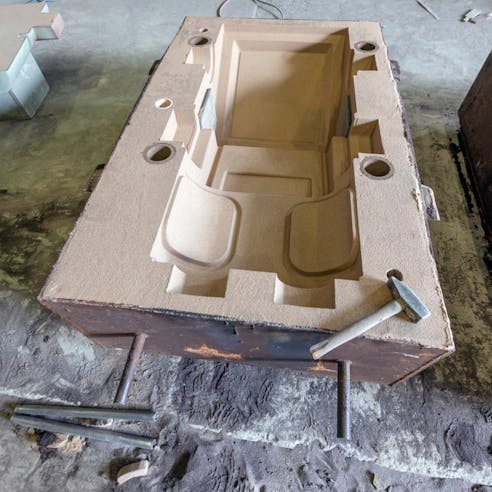
Producing the Pattern
The pattern is a replica of the item to be manufactured. This is a critical part of the process as it will dictate the dimensions of all units produced from it. The pattern needs to replicate details and dimensions as closely as possible. However, in some areas, for example, if post-machining is expected (for a smooth surface finish or intricate detail), some additional width is added to the pattern. This means the cast components will have some machining allowance.
Patterns are typically created in wood, metal, or plastic. They need to keep their dimensional integrity over multiple uses.
Creating the Mold
The mold is created over the pattern using a container called a flask. Typically, molds are made in two halves: the upper half is called the cope, and the lower half is called the drag. The sand is molded around the pattern to take on its shape, including all the detail and accurate dimensions. Once the pattern is removed, the mold material has a cavity within it.
Pouring the Metal Into the Mold
The molten metal is then poured into the prepared mold through a gating system. This gating system releases the metal in a controlled manner to ensure that the cavity is filled, without trapping air or partially filling any areas.
Shakeout
The metal is allowed to cool and solidify within the sand mold. The mold is then opened to remove the metal casting and allow it to cool further. However, it can take significant effort to remove the sand from the casting without damaging the new part, depending on the complexity of the part. The mold can be mechanically vibrated, or the sand can manually be broken out.
Final Operations
Once the part has been removed, it is cleaned thoroughly to ensure all sand and residue have been removed. Depending on the part, it may need to be prepared for machining. In terms of the sand, it is collected and either recycled (in some cases) or disposed of.
Types of Sand for Sand Casting
Sand casting can be carried out in several different ways. Different minerals can be used as the sand, and different binding agents (such as clay or resin) provide sand molds with different properties and capabilities. Listed below are the types of sand for sand casting:
- Green Sand
- Silica Sand
- Resin Sand
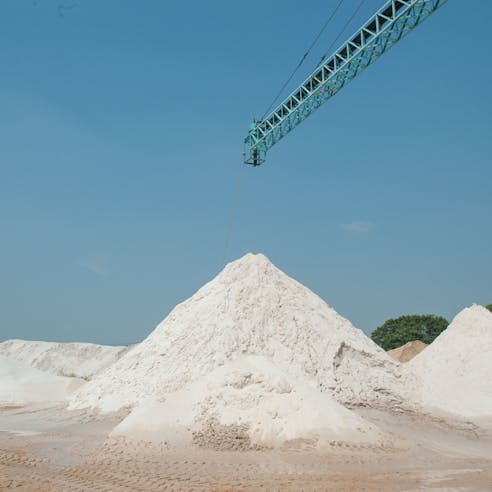
Green Sand
Green sand casting is the most popular type of sand casting. It is called green sand not because it is green in color, but because the sand contains moisture like green wood. Green sand is a mixture of bentonite clay (5–11%), water (2–4%), and some other materials (3–5%), with the balance (75–85%) being sand. This mixture binds well and is easily moldable into a casting mold. However, the sand is not reusable for casting. The process required to separate the sand into its components again is expensive, so the material is often recycled for other purposes.
Green sand casting is easy to use for many components, usually up to an approximate size of 500 lb. This means that it is used for many different engine components, bushes, impellers, etc.
Silica Sand
Silica sand, essentially the same as quartz sand, is a common sand used in different casting methods. Silica sand is made up of grains of silicon dioxide (SiO2). Quartz is a particular crystalline form of SiO2. The silica sand can be used together with clay and water for green sand casting, or together with a chemical resin for resin sand casting.
Silica sand is the most commonly used, but alternatives include zircon sand (ZrSiO4) and chromite sand (FeCr2O4).
Resin Sand
Resin sand casting uses a resin mixed into the sand, which reacts chemically to harden and bind the mold. After the casting is complete, the mold is broken away and is not reused. However, the sand can be recovered from the hardened resin to reuse the sand for another mold.
Resin sand casting is typically applied to very large metal castings, in the order of tons of material. The resin sand mold has a high strength and a high temperature resistance, allowing a wide variety of metal castings to be made using this process.
Sand Casting Materials
Sand casting can be used to cast a wide variety of metals. Some of these are explained below:
- Gray Iron
- Ductile Iron
- Stainless Steel
- Alloy Steel
- Carbon Steel
- Aluminum
- Brass
- Effective Utilization of Metal
- Fewer Environmental Hazards From the Foundry Process
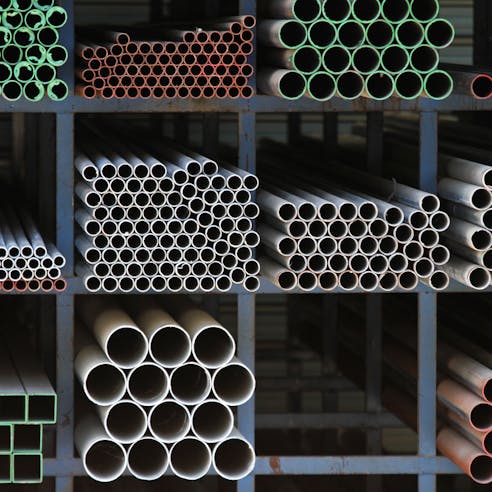
Gray Iron
Gray iron, also referred to as gray cast iron, is a type of cast iron that gets its gray color from the microfractures on the surface caused by graphite in the crystalline structure. Gray iron is the most widely cast material, as it is the cheapest iron to cast. It is used in multiple applications, such as maintenance covers and brake discs.
Ductile Iron
Ductile iron is a type of cast iron with a high carbon content (over 3%), and it is specifically formulated to provide high ductility. This ductility makes it less likely to fracture than gray iron, and therefore it can be used in applications that may include impact. This includes items such as bollards and gearboxes.
Stainless Steel
Stainless steel is generally only cast either by investment casting or by sand casting. Sand casting is generally quicker and more cost-effective but cannot provide small details and smooth surfaces like investment casting. Machining is expected to be necessary after using sand casting for stainless steel.
Alloy Steel
Alloy steel is any of a range of steels that include alloying elements such as chromium and manganese, in addition to carbon. Each alloying element is selected to improve a particular property of the final steel, such as corrosion resistance. Alloy steels are also often used as structural supports, ship components, and automotive parts which need to endure significant stress.
Carbon Steel
Carbon steel is an alloy of iron and carbon, with other minor alloying elements such as silicon and manganese. The higher the carbon content, the harder the steel. Low-carbon and mid-carbon steel are popular choices for castings due to their useful combination of ductility, strength, and wear resistance.
Aluminum
Aluminum can be cast using several different methods, including die casting and sand casting. It can be used in some applications as a lightweight alternative to steel.
Brass
Brass is generally cast using green sand casting. Common brass components that are cast include plumbing fixtures such as valve bodies and pipe fittings.
In need of custom sand casting services?
Sand Casting Advantages
Sand casting is a popular, versatile fabrication process, with several advantages as listed below:
- Simple Production Process
- Low-Cost Casting Molds
- Lower Production Costs
- Wider Material Choice
- High-Complexity Shapes
- Short Lead Time

Simple Production Process
Sand casting is a method that has been used for centuries. The process is simple and easy to understand. It uses relatively basic materials and tools. This simplicity has the advantage that mistakes in production are less likely and operators do not need to be highly skilled (relative to other metal fabrication methods).
Low-Cost Casting Molds
It is possible to make molds cheaply, particularly with green sand in an automated process. The equipment to make molds is relatively inexpensive and easily available.
Lower Production Costs
Overall, sand casting is consistently a cost-effective method of producing cast metal components. It is relatively easy to make molds—the sand is inexpensive and the tools and other materials are relatively simple.
Wider Material Choice
Sand casting can be applied for fabrication using a wide range of metals—primarily due to the sand’s resistance to high temperatures. Therefore, even metals with relatively high melting points can be cast. This makes sand casting very versatile and widely applicable.
High-Complexity Shapes
It is possible to fabricate components with complex shapes with sand casting. Once the pattern is produced accurately, multiple sand molds can be prepared quickly from that pattern. Internal cavities can also be cast by using cores in the sand molds. These cores can also provide relatively complex geometries to the interior of the cast component.
Short Lead Time
The ease and simplicity of making molds mean that sand casting can have a relatively short turnaround time for production. This is particularly true if the pattern for the part already exists.
Sand Casting Disadvantages
Sand casting does have limitations and disadvantages that need to be taken into account. These disadvantages are listed below:
- Handmade Process
- Low Strength
- Low-Dimensional Accuracy
- Rough Surface Quality
- Potential Casting Defects
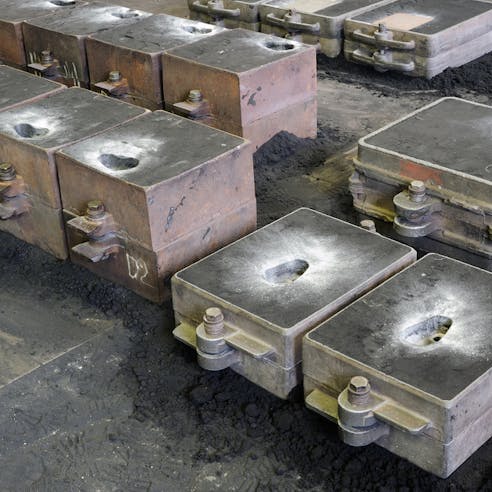
Handmade Process
Depending on the complexity of the component’s shape and the machinery available, sand molds may need to be made by hand. This requires sophisticated quality management to ensure repeatability and prevent mistakes.
Low Strength
Sand casting can be susceptible to producing casts with areas of high porosity, which in turn can lead to weak points in the cast. However, this risk is mitigated by careful selection and operation of the gating and the procedure for introducing the molten metal. Further, quality assurance testing protects against this risk.
Low-Dimensional Accuracy
There is a limit to the size and complexity of components that can be cast with sand casting due to the technique’s achievable dimensional accuracy. If too large a cast is attempted, sand molds can undergo some deformation, leading to a variation in dimensions. Sand casting is also not ideal for fine details and thin-walled elements. To accommodate for these, machining allowances are usually included and the part is then post-machined to the final dimensions.
Rough Surface Quality
Generally, sand casting is not capable of giving a perfectly smooth surface finish. The texture of the sand is transferred to the surface of the cast part. If a smooth finish is required on a cast part, it would need to be machined.
Potential Casting Defects
Sand casting is susceptible to a few potential casting defects. Some of these include porosity, inclusions (where impurities find their way into the cast metal from the sand mold), or mold shift (which leads to dimensional inaccuracies). However, each of these can be managed by the careful selection of the best type of sand casting for the component and the correct procedures for pouring in the molten metal.
Sand Casting Applications
Sand casting is applied for the fabrication of a wide range of parts. A small selection of them is described below:
- Air Compressor Pistons
- Bearings
- Blowers & Impellers
- Bushings
- Cams
- Electronic Equipment
- Engine Crankcases
- Engine Oil Pans
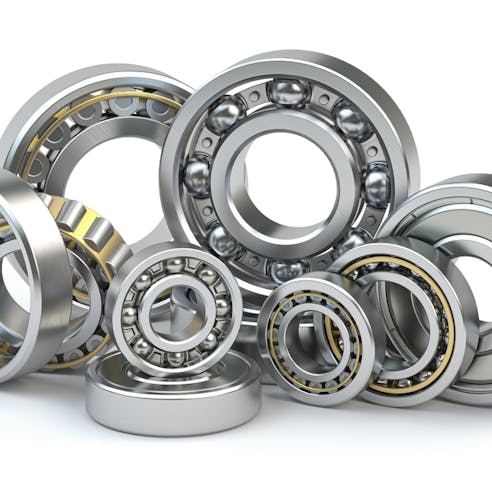
Air Compressor Pistons
Air compressor pistons are commonly cast. The pistons need to withstand extreme pressure differentials as they stroke within the air compressor. Sand casting is well suited to producing these heavy-duty pistons due to the width of the material needed. Machining is used for fine clearances around the head of the piston.
Bearings
Bearings, or more specifically bearing housings, are commonly cast components. These housings need to provide a firm platform for the bearing, able to withstand axial and radial loads without excessive vibration. These bearing housings are usually cast iron or cast aluminum.
Blowers & Impellers
Blowers and impellers are high-speed rotating equipment. These rotating elements need to withstand wear and erosion while experiencing high dynamic forces. Casting allows fairly complex geometries of the impellers, which can be taken advantage of to create efficiency improvements.
Bushings
Bushings are usually selected over bearings for slow-moving, heavy loads. Bushings themselves can be cast, most commonly in cast iron or bronze. The contact surface of the bushing is machined smooth.
Cams
Cams are used to translate between rotary motion and linear motion. In applications such as a motor vehicle engine, the rotating camshaft transfers the motion into the up-down movement required for opening and closing valves into the engine cylinders. In that example, the camshaft is executing thousands of cycles per minute and therefore needs to be strong and resilient.
Electronic Equipment
Various electric and electronic components can be cast. These can be large steel items like motor cases or small resin items such as transformer frames.
Engine Crankcases
The engine crankcase is the housing around the crankshaft and is often integrated into the engine block. Crankcases are commonly cast components due to their complex geometry and integrated cooling channels.
Engine Oil Pans
The oil pan is the lowest part of an engine, holding the lubricating oil. The oil pan needs to be suitable for heavy duty as it is exposed to bumps and scrapes underneath the vehicle. It can also have small fins cast into the bottom to assist in cooling the oil via the air passing underneath it.
Alternatives to Sand Casting Services
Xometry offers various alternatives to sand casting for metal part production. Each method applies to a particular range of materials and the different types of components to be produced. The alternatives are listed below:
- Die Casting
- Metal Injection Molding
- Metal Extrusion
- Stamping
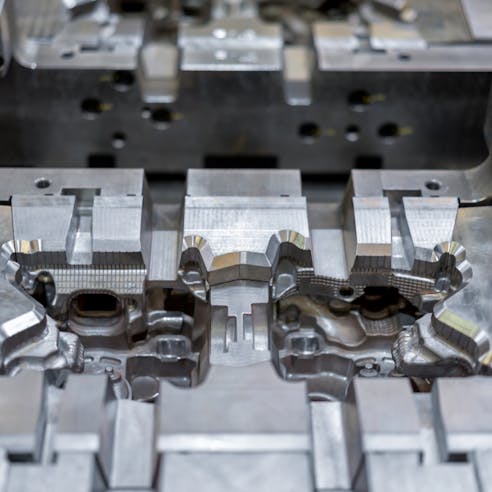
- Die Casting: Die casting is better suited to softer alloys of aluminum and zinc due to their lower melting points. Molten metal is injected into the die, which is then opened once the metal has solidified. Reasonably complex parts can be manufactured at volume this way, but some post-machining may be necessary.
- Metal Injection Molding: Metal injection molding is a fabrication process better suited to producing large quantities of small, complex components. It is a multi-stage process that begins with the powdered metal and polymer being injected into a mold. Once solid and de-molded, the polymers are removed, leaving a porous metal part. This is then sintered to produce the dense metallic part (with some shrinkage).
- Metal Extrusion: Metal extrusion is another manufacturing process available for metals. An extrusion is a component with a constant cross-section produced by forcing metal through a die. This process is most widely applied to aluminum. Aluminum extrusions are used extensively in modern buildings, such as in window frames and electrical housings.
- Stamping: Stamping is another metal fabrication process available for sheet metal to form shapes, features, and complex parts. Stamping can be applied to a variety of materials, including steel, stainless steel, copper, and brass.
Why Choose Xometry for Sand Casting Services?

Endless Options
Choose from millions of possible combinations of materials, finishes, tolerances, markings, and certifications for your order.

Easy to Use
Get started with our easy-to-use platform and let our experts take care of managing the project from locating the right manufacturing partner to delivery logistics.

Vetted Network
We are ISO 9001:2015, ISO 13485, and AS9100D certified. Only the top shops that apply to become Suppliers make it through our qualification process.